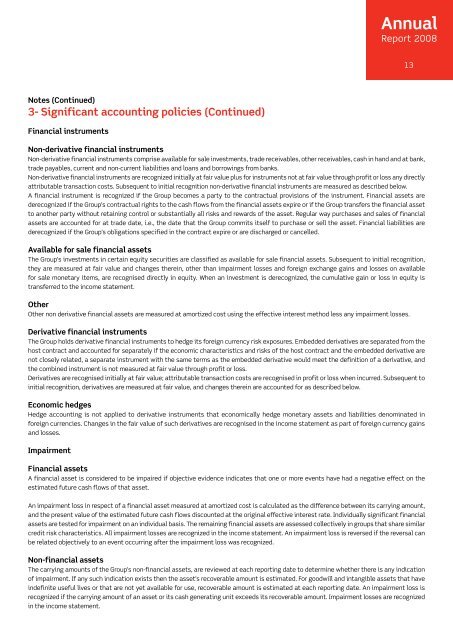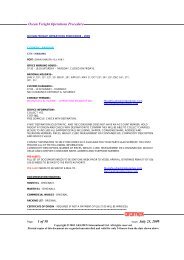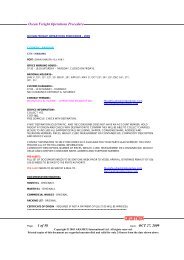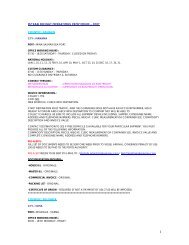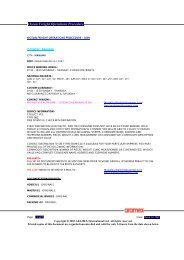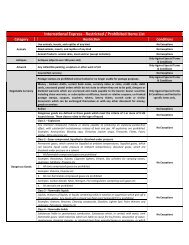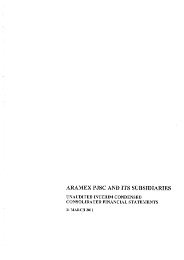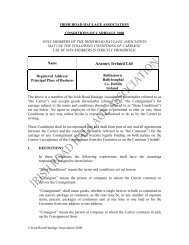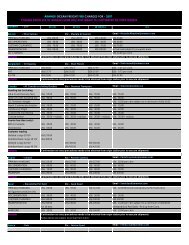Annual - Aramex
Annual - Aramex
Annual - Aramex
You also want an ePaper? Increase the reach of your titles
YUMPU automatically turns print PDFs into web optimized ePapers that Google loves.
Notes (Continued)<br />
3- Significant accounting policies (Continued)<br />
Financial instruments<br />
<strong>Annual</strong><br />
Report 2008<br />
Non-derivative financial instruments<br />
Non-derivative financial instruments comprise available for sale investments, trade receivables, other receivables, cash in hand and at bank,<br />
trade payables, current and non-current liabilities and loans and borrowings from banks.<br />
Non-derivative financial instruments are recognized initially at fair value plus for instruments not at fair value through profit or loss any directly<br />
attributable transaction costs. Subsequent to initial recognition non-derivative financial instruments are measured as described below.<br />
A financial instrument is recognized if the Group becomes a party to the contractual provisions of the instrument. Financial assets are<br />
derecognized if the Group’s contractual rights to the cash flows from the financial assets expire or if the Group transfers the financial asset<br />
to another party without retaining control or substantially all risks and rewards of the asset. Regular way purchases and sales of financial<br />
assets are accounted for at trade date, i.e., the date that the Group commits itself to purchase or sell the asset. Financial liabilities are<br />
derecognized if the Group’s obligations specified in the contract expire or are discharged or cancelled.<br />
Available for sale financial assets<br />
The Group’s investments in certain equity securities are classified as available for sale financial assets. Subsequent to initial recognition,<br />
they are measured at fair value and changes therein, other than impairment losses and foreign exchange gains and losses on available<br />
for sale monetary items, are recognised directly in equity. When an investment is derecognized, the cumulative gain or loss in equity is<br />
transferred to the income statement.<br />
Other<br />
Other non derivative financial assets are measured at amortized cost using the effective interest method less any impairment losses.<br />
Derivative financial instruments<br />
The Group holds derivative financial instruments to hedge its foreign currency risk exposures. Embedded derivatives are separated from the<br />
host contract and accounted for separately if the economic characteristics and risks of the host contract and the embedded derivative are<br />
not closely related, a separate instrument with the same terms as the embedded derivative would meet the definition of a derivative, and<br />
the combined instrument is not measured at fair value through profit or loss.<br />
Derivatives are recognised initially at fair value; attributable transaction costs are recognised in profit or loss when incurred. Subsequent to<br />
initial recognition, derivatives are measured at fair value, and changes therein are accounted for as described below.<br />
Economic hedges<br />
Hedge accounting is not applied to derivative instruments that economically hedge monetary assets and liabilities denominated in<br />
foreign currencies. Changes in the fair value of such derivatives are recognised in the income statement as part of foreign currency gains<br />
and losses.<br />
Impairment<br />
Financial assets<br />
A financial asset is considered to be impaired if objective evidence indicates that one or more events have had a negative effect on the<br />
estimated future cash flows of that asset.<br />
An impairment loss in respect of a financial asset measured at amortized cost is calculated as the difference between its carrying amount,<br />
and the present value of the estimated future cash flows discounted at the original effective interest rate. Individually significant financial<br />
assets are tested for impairment on an individual basis. The remaining financial assets are assessed collectively in groups that share similar<br />
credit risk characteristics. All impairment losses are recognized in the income statement. An impairment loss is reversed if the reversal can<br />
be related objectively to an event occurring after the impairment loss was recognized.<br />
Non-financial assets<br />
The carrying amounts of the Group’s non-financial assets, are reviewed at each reporting date to determine whether there is any indication<br />
of impairment. If any such indication exists then the asset’s recoverable amount is estimated. For goodwill and intangible assets that have<br />
indefinite useful lives or that are not yet available for use, recoverable amount is estimated at each reporting date. An impairment loss is<br />
recognized if the carrying amount of an asset or its cash generating unit exceeds its recoverable amount. Impairment losses are recognized<br />
in the income statement.<br />
13


